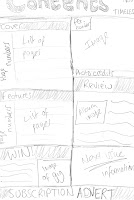(The 'Prezi' above shows the variety of images I have taken of Sabrina, my main artist for my music magazine)
Other Images
 These images I took are for my contents page. I like the lighting on these images; I used a combination of studio lights and natural sunlight on the photo on the left, as it gives a slight sepia effect. I used studio lights alone on the photo on the right with the newspaper background. I like the second image especially as the combination of the David Bowie Tshirt, the white tutu skirt and diamante headband make her look like she's an 80s pop princess, which reinforces the genre and era of my magazine. The sunglasses also have a Cyndi Lauper style to them.
These images I took are for my contents page. I like the lighting on these images; I used a combination of studio lights and natural sunlight on the photo on the left, as it gives a slight sepia effect. I used studio lights alone on the photo on the right with the newspaper background. I like the second image especially as the combination of the David Bowie Tshirt, the white tutu skirt and diamante headband make her look like she's an 80s pop princess, which reinforces the genre and era of my magazine. The sunglasses also have a Cyndi Lauper style to them.The photo on the left was taken at a concert and I will use this image on my contents page to advertise a festival.

















